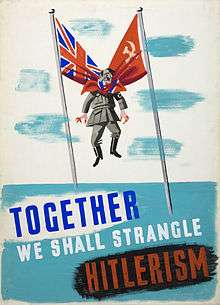Grand Alliance (World War II)

The Grand Alliance was an alliance made during World War II, which joined together the United States (led by Franklin Roosevelt), the Soviet Union (led by Joseph Stalin) and Great Britain (led by Winston Churchill). Roosevelt, Stalin, and Churchill are often known as "The Big Three."
The Grand Alliance is often called the "Strange Alliance" because it united the world's greatest capitalist state, the greatest communist state and the greatest colonial power.[1]
It was essentially an alliance of necessity, as all three needed to join together in order to defeat the threat of Nazi Germany.
Origins
The Grand Alliance to all intents and purposes was an alliance of convenience of the already allied United States and United Kingdom with the Soviet Union. The British had reason to ask for one as Germany, Italy and the Japanese Empire threatened not only the colonies of the British Empire in North Africa and Asia, but also the Home Islands. The USA felt that the Japanese and German expansion should be contained, but ruled out force until the attack by the Imperial Japanese Navy on Pearl Harbor on 7 December 1941. The Soviet Union, after the breaking of the Nazi-Soviet Pact by the instigation of Operation Barbarossa in 1941, greatly despised the unchallenged Japanese expansion in the East, particularly considering their defeat in several previous wars with Japan. They also recognized, as the US and Britain had suggested, the possibility of a Two Front war being of advantage to the Allies.
Thus, with two common enemies, the Grand Alliance (or the 'Big Three') was born, albeit onto shaky foundations.
Tensions
There were tensions in the Grand Alliance, between "The Big Three" (Roosevelt, Churchill and Stalin), although they were not enough to break the alliance during wartime.
There were essential ideological differences between the United States and the Soviet Union. Tensions between the two had existed for a long time, with the Soviets remembering America's armed intervention in the Russian Civil War and their long refusal to recognize the Soviet Union's existence as a state. The tension rose during the meetings from 1943-45 due to the ever growing list of demands from the USSR. Again tension increased when FDR died and the new president Truman didn't accept the demands of Stalin.[2]
Tensions also emerged over the length of time taken by the Allies to establish a Second Front in Europe, which Roosevelt had promised.[2]
References
- ↑ Ambrose, Stephen (1993). Rise to Globalism: American Foreign Policy Since 1938. New York: Penguin Books. p. 15.
- 1 2 Jones, Maldwyn (1983). The Limits of Liberty: American History 1607-1980. Oxford: Oxford University Press. p. 505.
- Winston Churchill. The Grand Alliance. Re-issued by Houghton Mifflin Harcourt, 1986. ISBN 978-0-395-41057-8.